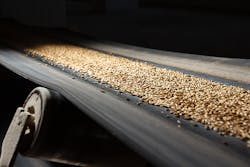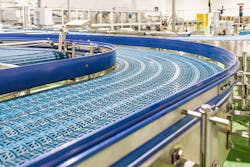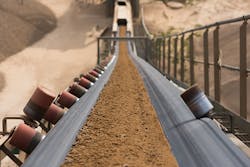Belt conveyors have been commonly used and widely employed to transfer and handle solids, bulk materials, and generally many forms of raw, semi-products, and final products in various types of plants and facilities.
The reliability and proper operation of a belt conveyor is related to the integrated reliability and operation of all components together. There have been different key parts and components in any belt conveyor such as structure (frame), idlers, pulleys, belt, driver system, and take-up system. Each affects the reliability, performance, and operation of the belt conveyor.
This article discusses key topics related to reliability, maintenance, and operation of belt conveyors including misalignment, mis-tracking, spillage, and slippage. These problems have been reported for many belt conveyors, and dealing with them and resolving them are important tasks in different operating plants.
Misalignment and deviations in structure
One of major problems in belt conveyors is misalignment and deviations in the structure, frames, and foundation. The conveyor frame or structure might be crooked or deformed. There have been many different forms and types for such problems, and there can be many different patterns and combinations of such deviations and deformations. The structure should be corrected and straightened in the affected areas.
In many cases, the structure is not level. Sometimes, the structural problem or deformation is because wrong type of fasteners are used or fasteners are too tight or too loose. In other cases, the structure or frame might not be strong enough to resist deformations and deflections under loads. In those cases, the structure or frame should be reinforced.
Idlers and pulleys
The second source is the misalignment imposed by idlers or pulleys due to many different types of issues and problems. Idlers or pulleys can be out-of-square with the belt centerline. Idler stands might not center on the belt; in these situations, idlers or their stands should be readjusted in deviated areas.
In general, too long distance between idlers has caused many problems. An optimum idler spacing is always recommended. Excessive sag of the belt between idlers can be an indication of long idler spacing or low take-up tension. This causes bulk materials to work and shuffle on the belt as it passes over idlers, which can cause other problems such as material slippage. The solution is the reduction of idler spacing, more belt tension, or both.
When the idler is not perfectly aligned with the belt, additional loading on the idler and additional drag on the belt can be introduced. When an idler is installed higher (elevated) than the adjacent idlers, the belt tension will add load to that idler.
Vertical misalignment is the vertical height difference between idlers. Angular deviation is another problem. Idler misalignment from the direction of belt travel can cause traverse slip between the idler and the belt, and addition drag to the overall conveyor operation.
Excessive forward tilt of trough rollers has caused some issues. It is desired to reduce forward tilt of idlers to less than 2° from vertical. Sticking and seized idlers can cause misalignment and many different sorts of problems. Attention is needed for bearings of idlers and pulleys and their greasing (lubrication). Both under-lubrication and over-lubrication have been reported as sources of problems.
Build-up of bulk material on idlers can generate some degrees of misalignment. This may mandate a thorough review of scrapers or other cleaning devices. Bulk material might be trapped between belt and pulley. For these cases, it is often required to install plows or scrapers on return run ahead of tail pulley. There has been focus on carrying rollers and the alignment exercises have traditionally concentrated on pulleys and carrying with little attention to return rollers. However, dirty, stuck, or misaligned return rollers have been sources of misalignment.
Belt imperfections
Another source of misalignment is the belt itself. For example, the belt might not be joined squarely, where poor splicing leads to misalignment. In most cases, the problematic splice should be removed, and the belt should be re-spliced.
Bowed belt is another widely reported problem, including for new belts. This condition may disappear during break-in. However, in many cases, the belt should be straightened or replaced. Belt edges may fold up on structure. The clearance should usually be adjusted and often more clearance is needed.
The cover of the belt is an extremely important part of the belt, and this cover should be selected after thorough review of handled bulk material and associated wear and damaging mechanisms. In many cases, the cover material may be wrongly selected, the thickness too small, or the quality was too low. This can be very problematic as if the cover is worn, the tension-carrying layers of the belt can be damaged, which can lead to a wide range of operational problems including belt mis-tracking and misalignment, and eventually to belt failure.
Finally, heat or chemical damage on the belt may occur. The cover of the belt is the first line of defence for such problems. The thickness and material of the cover should be suitable for each handled material and service, and case-by-case correct selection is mandatory. This is often overlooked which results in many operational problems and failures.
Route, profile, and transitions
The route, profile, and transitions have been known as another source of misalignment or generally operational problems. Smooth transition between different set of idlers or idlers and pulley are key for proper operation and reliability of a belt conveyor. In particular, an improper transition between the troughed belt section and terminal pulley(s) has been reported as the root cause of many problems including misalignment, and it is often necessary to adjust such transitions. Severe convex (hump) vertical curve also can be challenging. Idler spacing may be decreased in such a curve. It is always beneficial to increase curve radius.
Off-center or poor loading
A major source of misalignment is the loading. Off-center loading or poor loading have frequently been reported as the main source of induced misalignment. Ideally the chute or loading devices should load the bulk materials on the center of the belt at or near belt speed. However, in real operation, there can be deviations and some degrees of off-center loading. If considerable, this off-center loading can drive the belt to misalignment and can cause operational problems. The solution is to adjust the chute and other loading items to reduce or eliminate off-center loadings.
As the loading system is often complex and consists of many different parts and components (chutes, skirt-boards, etc.), all of them should work in concert for proper, on-center loading. Skirt-boards improperly adjusted or of wrong material can cause many different operational problems including misalignment.
The dimensions, gap, and tolerances should be adjusted properly. The contact between metallic parts and belt should be avoided, otherwise the belt might get damaged. Typically there should be a minimum 25-40 mm gap between the metallic parts and the belt, with the gap increasing in the direction of belt travel. The skirt board rubber should fill this gap in a way that does not cause excessive friction or off-center forces.
Chutes or main loading containers can be the source of many operational problems, such as bulk material getting jammed in chutes. Too often, the redesign of chutes is necessary for proper angle and width. Bulk material hanging up in or under the chute has been another issue. There can be a wide range of solutions to deal with these problems. Baffles might be used to properly guide bulk materials. Too often, the width of chute was not wide enough, and the chute should be widened. Impact of bulk material on the belt can cause excessive wear or damage. It is usually required to reduce the impact energy by improving the chute and loading system configuration.
Slippage
Slippage of the belt on the drive pulley can occur on a belt conveyor. One option to solve this problem is to increase the take-up tension (belt tension); however, there can be limits, and too-high tension in a belt can usually cause another set of problems. For instance, sometimes high belt tension can lead to lift-off of the belt in certain areas. A better solution to fix slippage on drive pulley is to increase the arc of contact. Another solution is to apply a better lagging for the pulley.
The pulley lagging might wear in a short time, and in such a case they should be replaced with a new or better one. In general, insufficient traction between the belt and drive pulley is a major problem, which can be intensified by wear and tear over time, dirt and debris, and other operational effects. Certain safety margins such as higher belt wrap or better safety factors should always be considered.
Often pulleys are selected that are too small, which causes problems such as excessive belt stresses and belt wear, premature belt failure, slippage, etc. In general, large pulleys are better for operation, a good investment that will be paid back by longer life of the belt and a better overall reliability and operation.
Material spillage also has been a great concern for many belt conveyors, with misalignment itself often leading to bulk material spillage. To solve the spillage, either eliminate the misalignment, improve loading and transfer conditions, install cleaning devices, and/or improve maintenance.
Training and operating conditions
A key question to ask when dealing with the belt misalignment is how a belt conveyor performs in different operating conditions. In particular, it should be clearly determined how the operation and misalignment is affected in different empty, loaded, and fully-loaded conditions as well as when the load varies.
A normal training sequence starts with the return run working toward the tail pulley and then following with the top run in the direction of belt travel. The process should be started with the belt empty. After tracking is completed, run the belt with a load and recheck tracking. It is often recommended to complete tracking in three steps: (1) minimum possible load, (2) a step between the minimum and full-load, and (3) at full-load.
Tracking adjustment is done while the belt is running and should be spread over some length of the conveyor preceding the region of trouble. The adjustment may not be immediately apparent. The belt should be operated for several minutes and at least 4 or 5 full belt revolutions after each idler adjustment to determine if additional tracking is required.
Even when an adjustment is apparent, that adjustment should be confirmed after a few minutes of running. After the adjustment, if the belt has overcorrected, it should be restored by moving back the same idler(s), and not by shifting additional idlers or rollers. If the belt runs to one side at a point or points on the conveyor structure, the cause will probably be due to the alignment, or levelling of the structure, or to the idlers and pulleys immediately preceding that area, or a combination of these factors. If a section or sections of the belt run off at all points along the conveyor, the cause is possibly in the belt itself, in the belt not being joined squarely, or in the loading of the belt.
Complex challenges
A particular challenge with belt conveyors is that multiple deviations and issues can be combined to produce a complex situation, and this combination of problems sometimes produces cases where the root cause of failure is not clear. However, if there are a sufficient number of belt revolutions, the running pattern may become clear. In cases where a running pattern does not emerge, it is strongly suggested that the full tracking procedure should be employed. It is quite likely that the erratic performance will be resolved in the process.
There have been many cases that after many attempts and correction, the belt will still run off-center around the tail pulley and through the loading area, or the belt may even be hitting the structure. For such cases, training idlers might be used.
Conclusion
A systematic approach is needed for the alignment and tracking of a conveyor belt. The first step is to examine some of key components of the belt conveyor system such as structure, frames, and the belt itself to learn how they affect belt tracking and alignment. Tracking and alignment of the belt is mainly a process of adjusting idlers, pulleys, and loading conditions in a manner that will correct any tendencies of the belt to run incorrectly.
Amin Almasi is a machinery/mechanical consultant in Australia. He is chartered professional engineer of Engineers Australia (MIEAust CPEng – Mechanical) and IMechE (CEng MIMechE) in addition to a M.Sc. and B.Sc. in mechanical engineering and RPEQ (Registered Professional Engineer in Queensland). He specializes in mechanical equipment and machineries including centrifugal, screw and reciprocating compressors, gas turbines, steam turbines, engines, pumps, condition monitoring, reliability, as well as fire protection, power generation, water treatment, material handling and others. Almasi is an active member of Engineers Australia, IMechE, ASME, and SPE. He has authored more than 200 papers and articles dealing with rotating equipment, condition monitoring, maintenance, condition monitoring, fire protection, power generation, water treatment, material handling and reliability. Contact him at [email protected].




